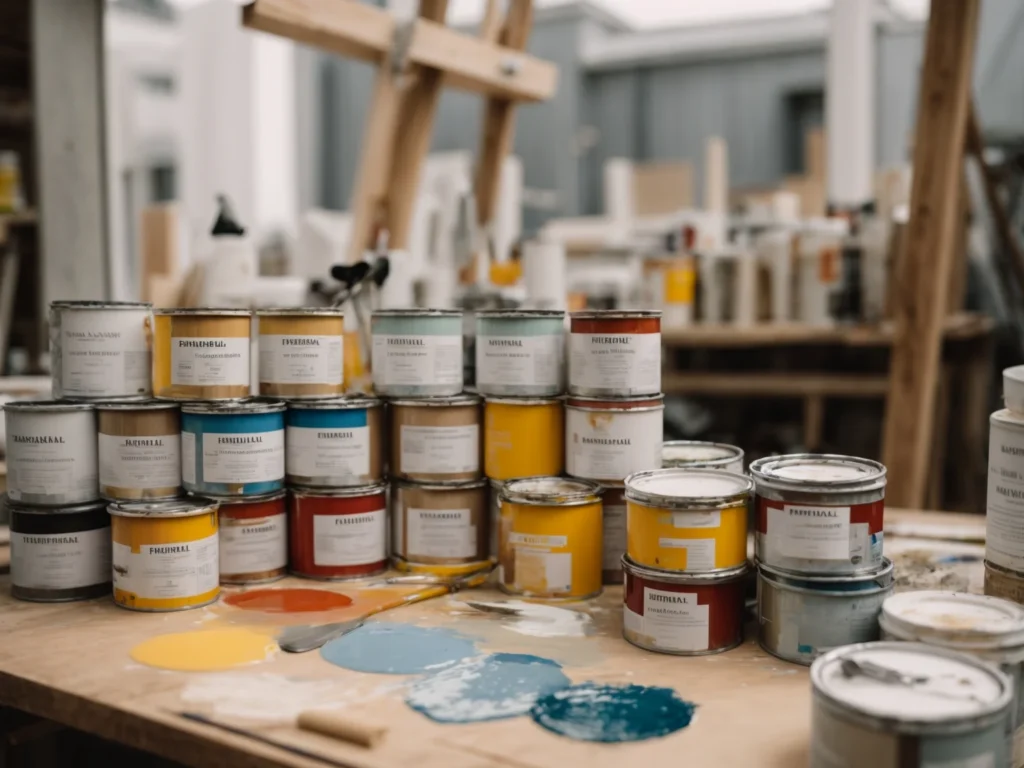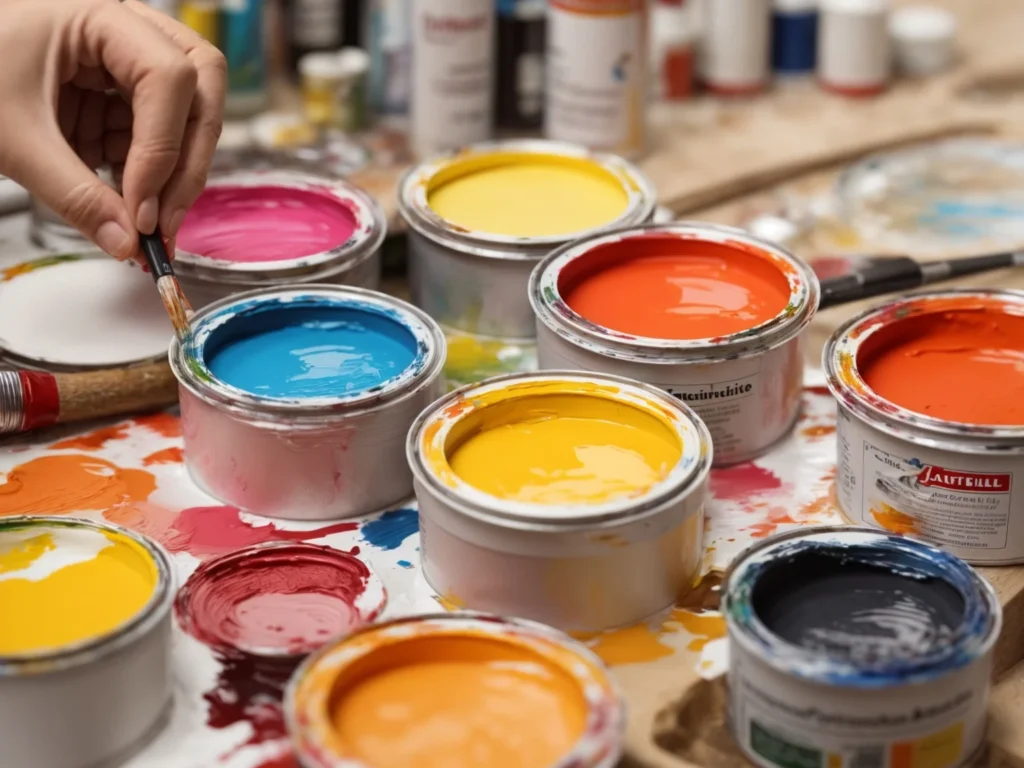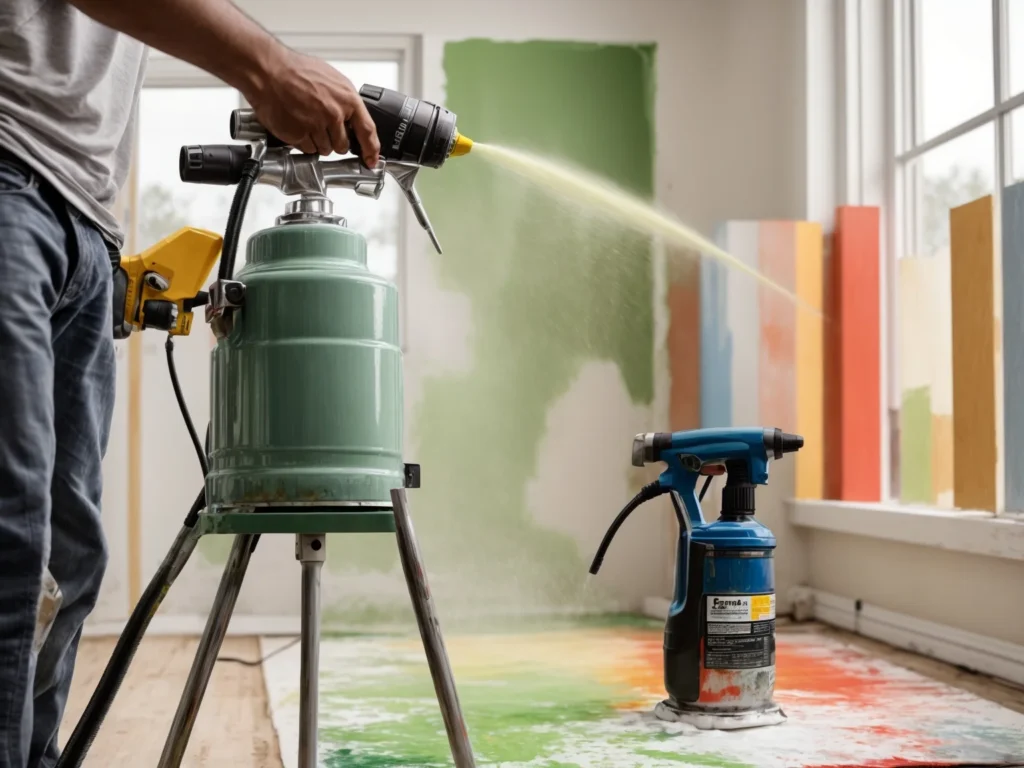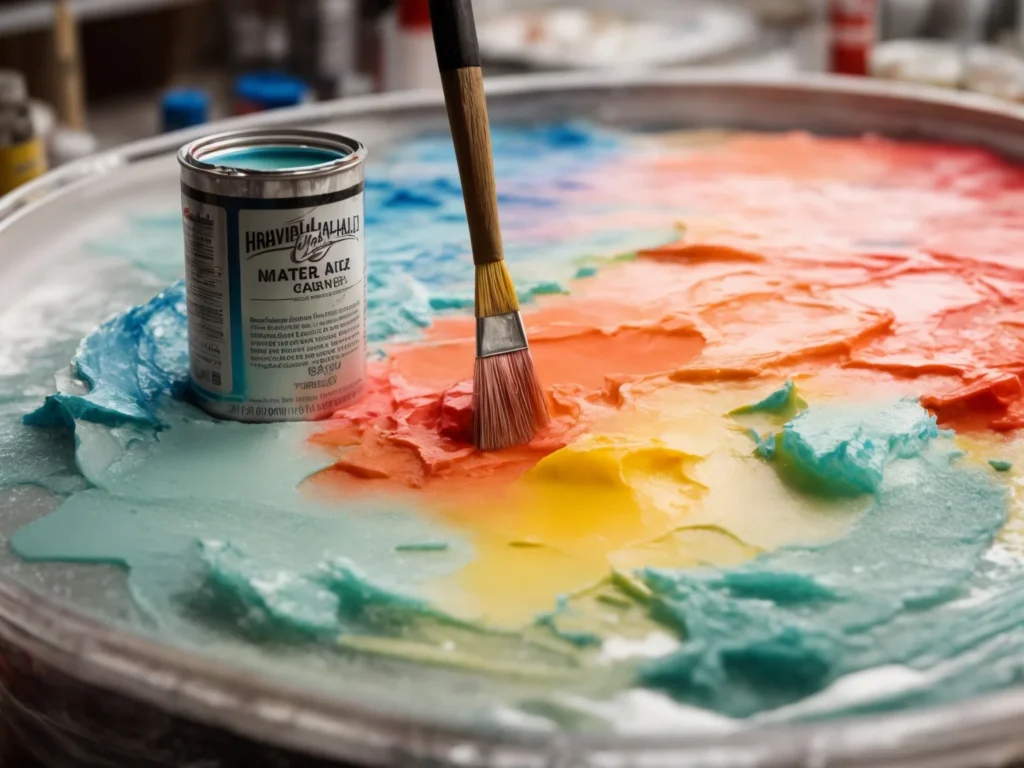When starting any painting project, choosing the right type of paint is key. Two of the most common options for both indoor and outdoor surfaces are acrylic and latex paints. But what exactly sets these two popular paint categories apart? Understanding the differences helps you pick the best one for your needs.

Acrylic vs Latex Paint Comparison Chart
| Property | Acrylic Paint | Latex Paint |
| Composition | Pigments in acrylic polymer emulsion | Pigments in acrylic resin emulsion suspended in water |
| Key Ingredients | Acrylic polymers, resins, pigments, water, fillers | Acrylic resin, pigments, water, additives |
| Durability | Very durable, retains hardness in changing conditions | Somewhat flexible to adapt to expansion/contractions |
| Typical Lifespan | 10-15 years outdoors, 2+ years indoors | 5-7 years indoors before needing repaint |
| Main Uses | Exterior surfaces, outdoor murals, metals, crafts | Interior walls, trims, ceilings, furniture |
| Drying Time | Dries quickly within an hour | Dries slower over 6-8 hours |
| Finish | Matte to high-gloss | Flat, matte, eggshell, semi-gloss, gloss |
| Cost | $30+ per gallon for artists acrylics | $10-30 per gallon for basic interior latex |
| Clean Up | Water clean up while wet | Water clean up while wet |
| Odor | Strong odor requires good ventilation | Low odor suitable for indoor use |
Composition and Basic Characteristics
The main difference between acrylic and latex paint comes down to their chemical compositions. This impacts their properties and performance.
What is Acrylic Paint Made Of?
Acrylic paint consists of colored pigments that are suspended in acrylic polymer emulsion. This emulsion is a binder containing acrylic resin, which is a plastic-like material made from acrylic acid derivatives.
Some key ingredients in acrylic paint include:
- Pigments for color
- Acrylic polymers and resins
- Water
- Fillers like chalk or clay
- Additives and preservatives
So while water-thinned, acrylic paints rely on acrylic polymers for adhesion and durability rather than being purely water-based.
What is Latex Paint?
Latex paint is a water-based emulsion paint made from acrylic resins suspended in water. Though commonly called “latex,” it contains zero natural latex rubber. The “latex” refers to the paint’s ability to stretch and elasticity.
The main components of latex paint include:
- Pigments for color
- Acrylic polymer resins
- Water as the carrier
- Additives like glycols and coalescents
- Preservatives and thickeners
So both acrylic and latex paints use types of acrylic resin, but latex has water as the main thinning agent rather than chemicals. This gives latex paint more of a water-based makeup.
Durability and Flexibility
Acrylic and latex paints perform differently when dry thanks to their chemical versus water-based formulas. This leads to differences in durability and flexibility.
Acrylic Paint Durability
The acrylic polymers provide acrylic paint with excellent strength and durability compared to other paint types. Once fully cured, acrylic paint maintains its hardness and adhesion even when exposed to changing weather and temperatures.
Acrylic paint’s durable plastic-like binder allows it to last up to 10-15 years on exterior surfaces. It resists chipping, cracking, and peeling better than other paints.
Latex Paint Flexibility
Though not as hard and durable as acrylic when fully dry, latex paint remains somewhat flexible. This gives latex paint better elasticity to expand and contract with temperature swings and surface movements.
Latex paint usually lasts up to 5-7 years on interior walls and ceilings before needing repainting. It can crack or peel if the surface flexes too much.
Acrylic’s Weather Resistance
Thanks to its durable acrylic resin binders, acrylic paint stands up well to sun, rain, snow, and changing seasons when used for exterior surfaces. It resists fading, yellowing, and wear from outdoor exposure better than latex.
Latex for Interior Use
Latex paints are designed for indoor use on walls, ceilings, and trims. They lack the binder strength for exterior durability. Latex works well inside because temperature changes are smaller indoors.
Application and Usability
Acrylic and latex paints behave somewhat differently when applying them to surfaces and during drying. This impacts their ease of use.
Ease of Application
Latex paint tends to be thicker than acrylic straight from the can. It goes on smoothly with minimal drips and splatters. The water base allows it to blend seamlessly.
Acrylic paint is thinner with a shorter drying time. Care must be taken to avoid drips when applying. It can also create textured brush strokes based on thickness.
Surface Adhesion
When used on properly primed surfaces, both latex and acrylic paints adhere well. Latex works best on drywall, plaster, wood, and interior bricks. Acrylic better adheres to metals, exterior wood, concrete, masonry, plastic, and more.
Drying Time
One major difference between latex and acrylic is drying time. Acrylic paint dries much faster, usually within an hour. Latex takes up to 8 hours to fully dry since the water takes longer to evaporate.
The fast drying time of acrylic can make blending and color mixing more challenging compared to slower drying latex.
Cost and Availability
When evaluating the costs of acrylic vs. latex paint, consider both upfront price and potential longevity.
Acrylic Paint Cost
Thanks to its higher content of acrylic polymers, acrylic latex paint is more expensive than basic latex wall paints. However, its durability provides better value long-term.
Professional artist-grade acrylics have the highest concentrations of pigments and acrylic binders, costing $30+ per tube or bottle. Consumer craft acrylics offer a less expensive option.
Latex Paint Affordability
Latex wall paints are widely available at home improvement stores for as little as $20-30 per gallon. Lesser grades with lower acrylic content can be under $10 per gallon. This makes latex a budget-friendly choice.
Longevity Factors into Value
The 10-15 year lifespan of exterior acrylic makes its upfront cost worthwhile over multiple repaints of latex. For interior walls, cheaper latex may suffice since repainting happens frequently.
Health and Safety Considerations
Paint fumes and ventilation needs differ between acrylic and latex options based on their chemical makeup.
Acrylic Paint Ventilation
Acrylic paint contains solvents and chemicals that create strong fumes, especially when spraying. Proper protective gear and ventilation are essential when using acrylics.
Latex Paint Safety
The water base of latex paint makes it lower odor and safer for indoor use than solvent acrylics. Basic ventilation is still advised but not to the same degree as acrylics.
Potential Skin Irritation
Both paint types can cause skin irritation or allergic reactions, especially with repeated long-term exposure. Using protective gloves is recommended.
Environmental Impact
In terms of eco-friendly qualities, latex paint has an advantage over chemical-based acrylics.
Acrylic Paint Considerations
Solvent acrylics contain volatile organic compounds (VOCs) linked to smog and ground-level ozone damage. Improper disposal also leads to soil and water pollution.
However, low and zero-VOC acrylic paint formulas are available for better eco-friendliness. Most brands meet current VOC regulations.
Latex Paint Sustainability
The water base gives latex very low VOCs. Clean latex paint can even be safely washed down the drain rather than requiring hazardous waste disposal. This gives latex paint an environmental edge.
Aesthetics and Finish Quality
The type and quality of resins and binders impact the colors, finish, and hiding power of acrylic and latex paints.
Acrylic Paint Color Options
With professional grades containing highly concentrated pigments, acrylic paints provide unmatched color depth and vibrancy. Consumer acrylics offer a diverse color palette as well.
Acrylic paint appears glossy when wet. Once dry, it cures to a matte, satin, or semi-gloss finish based on the formulation.
Latex Color Range
Latex paint is available in virtually any color for interior decoration needs. It hides previous colors well but lacks the richness of fine art acrylic pigments.
Wet latex has a milky appearance. It dries to a flat, matte, eggshell, satin, or high-gloss finish. Higher acrylic resin content improves durability and sheen.
Color Fastness Over Time
The durable binders of acrylic paint prevent color fading over years of sun exposure. Latex paint colors may shift slightly over time with indoor lighting exposure.
Hiding Power
Thick latex paint helps conceal existing wall colors and imperfections in fewer coats. Acrylic provides thinner coverage that requires more layers for solid color hiding.
Specialized Uses
Beyond basic interior walls and exterior surfaces, acrylic and latex paints differ in specialty applications based on their formulations.
Suitable Surfaces for Acrylic Paint
Thanks to its strong adhesion and durability, acrylic paint works on:
- Outdoor murals, signs, and metal
- Concrete, stucco, masonry
- Auto bodies, boats, trailers
- Crafts, models, miniatures
- Ceramics, pottery, sculpture
- Canvas, paper, cardboard
Where to Use Latex Paint
Latex paint works best on common indoor surfaces like:
- Drywall, plaster
- Wood trim, cabinets, furniture
- Ceilings, doors, siding
- Paper, cardboard, foam
- Fabric painting projects
Waterproofing Uses
Acrylic paint’s resin binders create a waterproof seal. Latex paint remains somewhat permeable. For outdoor murals or cement paints, acrylics provide better waterproofing than latex.
Cleaning and Maintenance
The resilience of cured acrylic and latex paint determines how easily they can be cleaned and maintained over time.
Cleaning Acrylic Painted Surfaces
Thanks to acrylic’s durable binder, acrylic paint is easy to clean without damaging the paint surface. Warm soapy water, or mild solvents on stubborn stains, safely remove dirt without deteriorating the paint.
Cleaning Latex Paint
Latex paint is more delicate than acrylic, so aggressive scrubbing or abrasive cleaners could wear away the surface. Gentle cleaning solutions and microfiber cloths prevent damage to latex paint.
Long-Term Maintenance Needs
Properly applied exterior acrylic paint lasts for over a decade before needing touch-ups or recoating. Latex may need spot repairs and full repainting in 5-7 years.
Recoating and Touch-Ups
The tight adhesion of cured acrylic paint prevents touch-ups or new coats from bonding and sealing properly without sanding first. Latex repainting is more forgiving.
Which paint is better latex or acrylic?
Acrylic paint is better for outdoor surfaces and applications needing maximum durability. Latex paint works well for indoor walls and ceilings that require repainting every few years.
FAQ
What is the difference between 100% acrylic and 100% acrylic latex?
100% acrylic refers to an acrylic paint using solely acrylic resins in its binder, while 100% acrylic latex uses mostly acrylic resins suspended in a water base rather than solvents or coalescing agents.
Why is latex paint better?
For indoor use, latex paint is better than acrylic thanks to its lower odor, lower cost, easier application, and thicker consistency for hiding imperfections. It offers good durability for 3-5 years on interior surfaces.
Is latex paint waterproof?
Latex paint is low-odor and cleans up with water, but it is not fully waterproof. The water-based acrylic binders allow slight penetration of moisture. For a waterproof paint, solvent-based 100% acrylics are better.
Can acrylic paint be used indoors?
Yes, acrylic paint can be used for indoor murals, accent walls, furniture or craft paints. Good ventilation is important. For indoor walls needing repainting every few years, standard latex wall paint may be a better choice.
Conclusion
When comparing acrylic vs latex paint, the main differences come down to acrylic’s chemical composition making it stronger and longer-lasting than water-based latex paints. Both have benefits for particular applications. Choosing wisely ensures your paint finish withstands the conditions it will face.
For longevity in exterior or harsh environments, durable acrylic paint is the best bet. Inside, affordable latex paint works great for walls and ceilings that need repainting every few years. Pick the option best suited for your specific project needs. With proper prep and application, both acrylic and latex paints create beautiful, professional-quality finishes.





